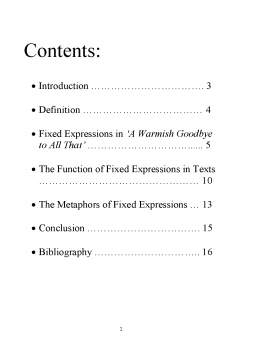Extras din referat
‘In investigating the properties of lexical items
one is looking at the inmates of a prison (the
lexicon) who have in common only the fact of
their lawlessness (Di Sciullo and Williams,
1987).’
Understanding language involves recognition and access to not only individual words, but also to a vast array of fixed expressions – idioms, , formulae such as proverbs and catchphrases, and anomalous or ill-formed collocations , common quotations, names, title, slogans, song lyrics, etc. In general the studies of fixed expressions concentrate on their typological and syntagmatic properties. Attention is given to such things as the degree of their lexical and syntactic frozenness, or their transformation potential; and even the primary characteristic of idioms, their non-compositionality as lexical units, may be seen as a matter of the interpretation of syntagm. However, it is their paradigmatic properties which are of importance in relation to interaction. Fixed expressions represent meaningful choices on the part of the speaker/writer. They are single choices and, as with other kinds of lexical item, their precise values and force should be considered in terms of the paradigm operating at each slot or choice. By taking into account paradigmatic operating as well as syntagmatic aspects, it is possible to assess the way in which fixed expressions contribute to the content, structure and development of a text.
The term fixed expressions has been used to refer to a variety of linguistic expressions. Fixed expressions refer to specific combinations of two or more words that are typically used to express a specific concept. The defining feature of fixed expressions is that it is a word combination, stored in the Mental Lexicon of native speakers, that as a whole refers to a (linguistic) concept. This makes fixed expressions “non-compositional” in the sense that the combination and structure of their elements need not be computed afresh, but can be retrieved from the Mental Lexicon. Among fixed expressions are idioms, collocations, metaphors, support verb constructions, phrasal verbs, institutionalized phrases, sayings, proverbs and formulaic expressions. Examples of fixed expressions are the English expressions in (1):
(1) a. spill the beans, shoot the breeze (idiom)
b. the eye of a needle, the evening falls (metaphor)
c. dogs bark, sound asleep (collocation)
d. make progress, take a bath (support verb construction)
e. Don’t count your chicks before they hatch, Curiosity killed the cat (proverb, saying)
f. The X-er, the Y-er e.g. The more, the merrier (construction)
g. to cost an arm and a leg, listen like a police officer (simile)
h. at school, by and large (institutionalized phrase or set phrase)
Some of these expressions are by no means fixed sequences of words, thus researchers adopt other terms like multi-word units, multi-word lexemes, multi-word expressions (Sag et al. 2001), phrasal lexical items (Everaert and Kuiper, 1996) or phrasal lexical entries (Sailer, 2000).
A satisfactory definition of fixed expressions is difficult due to the varied nature of the data. Aiming at a definition of fixed expressions to be adopted by lexicographers, Everaert (1993) proposed the following:
‘A combination of two or more words that must at least satisfy the (a) condition and perhaps, but not necessarily, condition (b) and/or (c):
(a) the word combination is fixed;
(b) the combination as a whole has a non-compositional or partially compositional meaning;
(c) the syntactic/morphological behavior of the fixed expression and/or its parts is not to be expected given the syntactic/morphologic behavior of the individual words or the combination as a whole (Everaert, 1993, pg. 18).’ Everaert’s definition emphasizes one necessary feature, that is, the lexical fixedness between the words inside the expression, allowing potential idiosyncrasies in the morpho-syntax and/or semantics. Fixed expressions constitute a non-negligible portion of the language in use, perhaps of the various types of phenomena covered by the term.
Fixed expressions, especially highly colourful and metaphorical idioms and proverbs, are comparatively infrequent. They appear to be more frequent in spoken text than written, although to date there are few extensive studies of their actual distribution. According to Rosamund Moon’s article about fixed expressions ‘The Analysis of Fixed Expressions in Text’, “a survey of 240 English proverbs finds that there are around 33 instances of proverbs per million words of Oxford-Hector Pilot Corpus, and that the average frequency of each of the proverbs is much less than one occurrence per million words: this list of proverbs consists of those best known to informants in a small survey, and it should be pointed out that the more frequent of these proverbs nearly always occur in exploited or truncated forms.”
Preview document
Conținut arhivă zip
- The Analysis of Fixed Expressions in Texts.doc

















